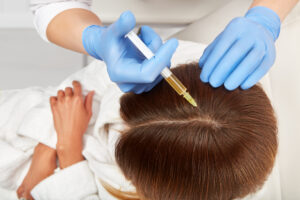Ideal body clinic hair loss treatments
Ideal body clinic hair loss treatments
Fotona hair restoration:
Fotona hair restoration is a non-surgical treatment that utilizes laser technology to promote hair growth and improve hair density. The procedure typically involves using specific wavelengths of laser light that stimulate the scalp, encouraging blood flow to the hair follicles and potentially enhancing their function.
- Laser Technology: Fotona lasers are designed to deliver energy to the scalp, which can help rejuvenate hair follicles and promote new hair growth.
- Minimally Invasive: The procedure is non-invasive, meaning there are no incisions or surgeries involved, making it a lower-risk option for hair restoration.
- Safety: Fotona treatments are generally considered safe with minimal side effects. Patients may experience slight redness or sensitivity, but these effects usually resolve quickly.
- Treatment Sessions: Multiple sessions are often required to achieve optimal results, and the exact number can vary based on individual needs and hair loss severity.
- Complementary Treatments: Fotona hair restoration can be combined with other hair loss treatments, such as PRP (platelet-rich plasma) therapy, for enhanced results.
Prp:
PRP (platelet-rich plasma) treatment is a regenerative therapy that uses a patient’s own blood to stimulate healing and promote hair growth.
How PRP Treatment Works
- Blood Collection: A small amount of the patient’s blood is drawn, usually from the arm.
- Centrifugation: The blood is then placed in a centrifuge, which spins it at high speed to separate the components. This process isolates the platelet-rich plasma from the red blood cells and other components.
- Injection: The concentrated PRP is injected into the scalp in areas where hair thinning or loss has occurred. The growth factors in the PRP are believed to stimulate hair follicles and promote hair growth
Benefits of PRP Treatment
- Natural and Safe: Since PRP is derived from the patient’s own blood, it minimizes the risk of allergic reactions or complications.
- Minimal Downtime: The procedure is relatively quick, often taking about 30 minutes to an hour, with little to no downtime for recovery.
- Improves Hair Thickness: Many patients report increased hair density and improved thickness after several sessions.
- Stimulates Growth: The growth factors in PRP can help revitalize dormant hair follicles and encourage new hair growth.
Typically, patients may need a series of sessions (e.g., once a month for three to four months) followed by maintenance treatments every few months to sustain results.
Exosomes: Exosomes are a newer development in the field of hair restoration and regenerative medicine. They are small extracellular vesicles secreted by cells that play a crucial role in cell communication and signaling. Here’s how exosomes are being utilized for hair loss treatment
How Exosomes Work
- Cell Signaling: Exosomes contain proteins, lipids, and RNA molecules that facilitate communication between cells. They can promote healing, reduce inflammation, and enhance cellular regeneration.
- Hair Follicle Stimulation: When applied to the scalp, exosomes can help stimulate dormant hair follicles, promote hair growth, and improve hair density.
- Mechanism: The growth factors and other bioactive molecules within exosomes help to activate the hair growth cycle and potentially rejuvenate damaged hair follicles.
Benefits of Exosome Therapy
- Natural Treatment: Since exosomes can be derived from the patient’s own cells (or from donor sources that are processed to ensure safety), they are considered a natural and biocompatible treatment option.
- Minimally Invasive: The treatment typically involves injections into the scalp and is generally well-tolerated with minimal discomfort.
- Rapid Recovery: Patients usually experience little to no downtime, allowing them to resume normal activities shortly after the procedure.
- Synergistic Effects: Exosome therapy can be combined with other treatments, such as PRP or laser therapy, to enhance overall results.
The procedure involves multiple sessions, often spaced a few weeks apart, depending on individual needs.
Microneedling:
Microneedling for hair loss is a minimally invasive procedure that involves using fine needles to create tiny micro-injuries in the scalp. This process stimulates the body’s natural healing response and can promote hair growth
How Microneedling Works
- Creating Micro-Injuries: The microneedling device punctures the scalp at controlled depths, which triggers a healing response.
- Stimulating Collagen Production: This process helps to stimulate collagen and elastin production, which can improve the overall health of the scalp.
- Enhancing Absorption: Microneedling can improve the absorption of topical treatments (like minoxidil or PRP), making them more effective.
Benefits of Microneedling for Hair Loss
- Promotes Hair Growth: The micro-injuries can reactivate dormant hair follicles, encouraging new hair growth.
- Non-Surgical: It’s a non-invasive treatment option, making it suitable for many patients.
- Minimal Downtime: Most people experience only mild redness or sensitivity afterward, allowing them to return to normal activities quickly.
- Safe and Effective: Microneedling has been shown to be effective for various types of hair loss, including androgenetic alopecia.
Multiple sessions are typically recommended (e.g., once a month for several months) for optimal results.


